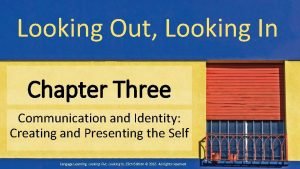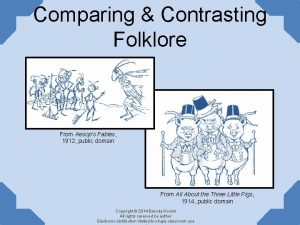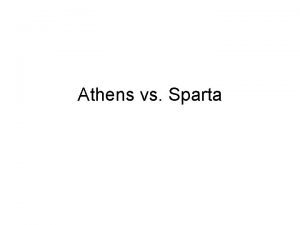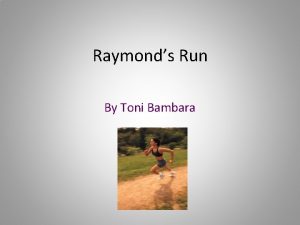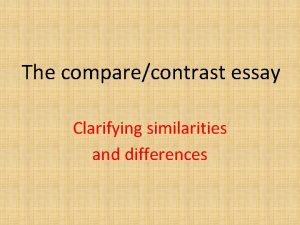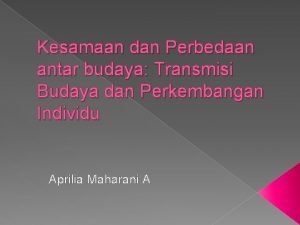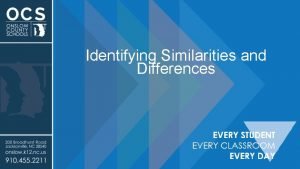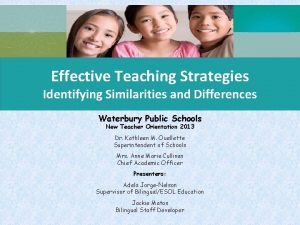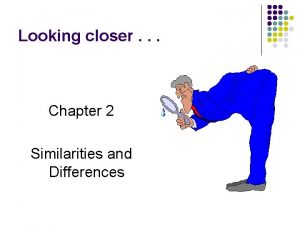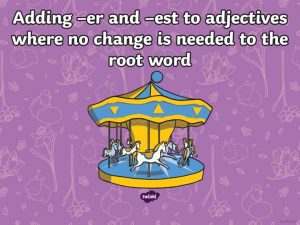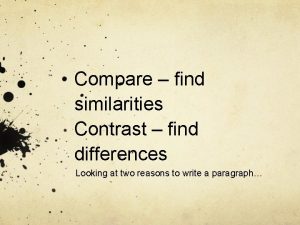Looking closer Chapter 2 Similarities and Differences Research














- Slides: 14

Looking closer. . . Chapter 2 Similarities and Differences

Research and Theory on Identifying Similarities and Differences l Explicitly teaching students to identify similarities and differences enhances their ability to understand use knowledge

Research and Theory on Identifying Similarities and Differences l Providing opportunities for students to independently identify similarities and differences enhances their ability to understand use knowledge

Research and Theory on Identifying Similarities and Differences l Representing similarities and differences in graphic or symbolic form enhances students’ understanding of and ability to use knowledge

Research and Theory on Identifying Similarities and Differences l Identification of similarities and differences can be accomplished in a variety of highly interactive ways l l Comparing Classifying Creating metaphors Creating analogies

Comparing – Classroom Practice Teacher-Directed Comparison Tasks l l Items Characteristics for comparison Student-Directed Comparison Tasks l l Items Characteristics for comparison Identifying the IMPORTANT characteristics is key when making comparisons

Graphic Organizers for Comparisons Comparison Matrix Characterist ics Items to be #1 1. compared #2 Similarities and Differences S D 2. S D 3. S D 4. S D 5. Venn Diagram S D

Classifying – Classroom Practice Teacher-Directed Classification Tasks l l Elements Categories Student-Directed Classification Tasks l l Elements Categories Critical to the task of classifying is an understanding of the rules that govern a class or category Membership.

Graphic Organizers for Classification Categories

Metaphors Teacher-Directed Metaphors l l First element Abstract relationship Student-Directed Metaphors l l First element Abstract relationship The key to using metaphors is the understanding that the two items are connected by an abstract or nonliteral relationship

Analogies l Teacher-Directed Analogies l Discuss and guide analysis of first relationship § l Discuss and guide analysis of how first relationship might apply to second set § l Subtract : Divide Teach whole analogy § l Add : Multiply Add : Subtract : Multiply : Divide Scaffold task The most complex format, requiring students to analyze relationships between relationships

Analogies l Student-Directed Analogies l Provide first relationship § l Students analyze and create second set § l Add : Multiply Subtract : Divide Scaffold task The most complex format, requiring students to analyze relationships between relationships

Graphic Organizers for Analogies is to (relationship) ________ as is to thermometer is to temperature (relationship) first measures incremental changes in second as odometer is to distance

Similarities and Differences l Teach directly l Have students practice independently l Teach and use graphic or symbolic representations l Use a variety of activities
 Looking out, looking in summary
Looking out, looking in summary Looking out looking in chapter 9
Looking out looking in chapter 9 Similarities with parents
Similarities with parents What are the ppst domain
What are the ppst domain Compare and contrast the ant and the grasshopper
Compare and contrast the ant and the grasshopper Compare sparta and athens
Compare sparta and athens Raymond's run text
Raymond's run text Wid wad and gad similarities
Wid wad and gad similarities Essay about similarities and differences
Essay about similarities and differences Cross cultural differences and similarities
Cross cultural differences and similarities Identifying similarities and differences
Identifying similarities and differences Marzano similarities and differences
Marzano similarities and differences Fascism similarities and differences
Fascism similarities and differences Identifying similarities and differences examples
Identifying similarities and differences examples Similarities and contrast
Similarities and contrast
